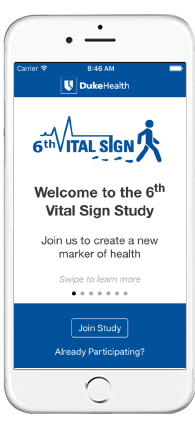
Contact: Sarah Avery
Phone: 919-660-1306
Email: sarah.avery@duke.edu
https://www.dukehealth.org
Walking Speed Could Be a New Indicator of Health
Smartphone study measures “6th Vital Sign” with a two-minute test
DURHAM, N.C. — Walking speed is making strides toward becoming a key metric of a person’s health with the launch of the 6th Vital Sign, a first-of-its kind study being conducted by the Duke Clinical Research Institute (DCRI).
The Duke research team is asking volunteers to download a free ResearchKit app from the Apple iTunes store, answer some questions and then take a two-minute stroll. The app securely uploads walking speed captured on a phone along with demographic data to calculate a reliable and personalized health measure.
“Walking speed is recognized, yet underutilized, as a measure and predictor of a person’s health. It can be used as a vital sign much like blood pressure, temperature, heart and breathing rate and pain,” said study team leader Janet Prvu Bettger, ScD, an associate professor and director of health policy and implementation science in Duke’s Department of Orthopaedic Surgery.

Vital signs measure the body’s basic functions and should be easy to measure at home, in a hospital or at a health clinic. “Mobility, or a person’s ability to move, reflects the health of all of our body’s systems,” Bettger said. On the other hand, immobility impacts a person’s muscles, heart, digestive system, joints, and even mood.
“As a 6th Vital Sign, walking speed can be used to track a person’s recovery from illness or injury, declines in health, or even risks for falls, or depression,” Bettger said. “Among older adults we know that walking speed can even be used to predict survival.”
The 6th Vital Sign study is designed to:
- Create walking speed norms based on mobile phone rather than clinic measures.
- Develop walking speed comparison charts by age and gender for all adults (like height and weight charts).
- Create maps of how walking speed varies by where people live.
- Increase awareness of the importance of walking speed.
- Make walking speed a vital sign used in homes, health care and communities around the globe.
“We are very excited by the possibilities of mobile apps such as the 6th Vital Sign to reach large cross-sections of the population and stimulate healthy behaviors,” said DCRI Executive Director Eric Peterson, M.D. “DCRI is committed to evaluating how we can use innovative mobile technologies in research as well as in promoting population health in general.”
To participate in the study, adults are being asked to download the 6th Vital Sign mobile app free from the iPhone Store, answer a few questions, and take a two-minute walk. Anyone living in the United States, over the age of 18, and with access to an iPhone 5s, 6, or 6 plus can join the study. (This is an iPhone-only and English language study at this time.) Participants will receive feedback on their walking performance compared to others their age and gender and can save or share their results. Participants can complete the walk test more than once and monitor their status over time to learn more about their own personal walking speed.
“We’re conducting this study because we don’t know enough about the walking speed across the human lifespan,” said Miriam Morey, Ph.D., a professor of medicine and senior fellow in the Center for the Study of Aging and Human Development at Duke.
“As we get older, our systems start to decline and we have age-related declines that are normal,” Morey said. “However, we can influence the pace of this decline by how we take care of ourselves. Right now, we don’t routinely measure walking and strength so we don’t know what’s going on – or what we need to be doing. The 6th Vital Sign study examines a new approach to be measuring mobility.”
“This research app allows us to create new mobile-phone based standards and norms for walking speed for people, first around the U.S. and eventually around the world,” Bettger said. “The more people who participate in the study, the more representative our findings. This will help us create more accurate predictions of future health and measure-based action plans to promote health, recovery from an injury, and prevention of falls. And because smart phones are so common among people of all ages, there is a great potential to engage an unlimited population in research and create new knowledge for entire populations.”
About the Duke Clinical Research Institute
The DCRI is the largest academic research organization in the world, with a mission to develop and share knowledge that improves the care of patients and populations through innovative clinical research. The DCRI conducts groundbreaking multinational clinical trials, manages major national patient registries, and performs landmark outcomes research. This research spans multiple disciplines, from pediatrics to geriatrics, primary care to subspecialty medicine, and genomics to proteomics. The 6th Vital Sign study was sponsored by the DCRI and represents a collaborative effort among the DCRI, and the Department of Orthopaedic Surgery, Divisions of Cardiology and Geriatrics in the Department of Medicine, and the School of Nursing at Duke.
